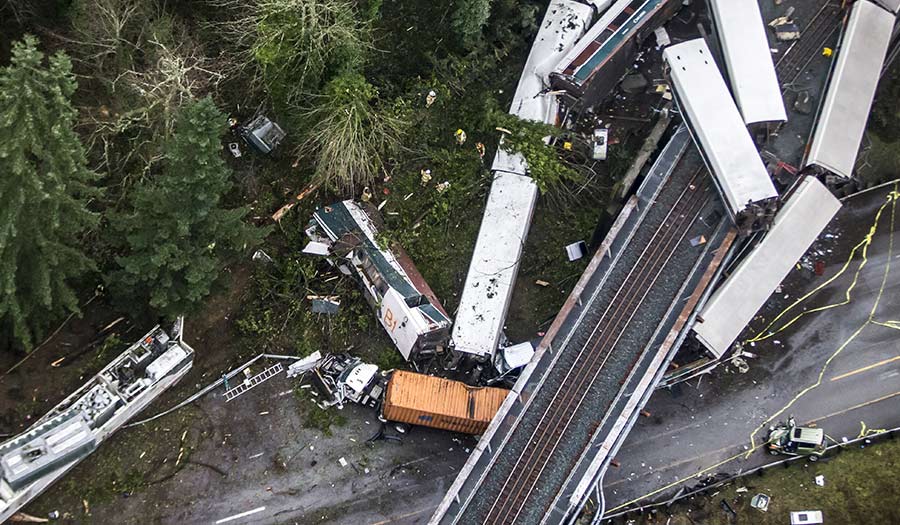 Bettina Hansen/The Seattle Times via AP
Bettina Hansen/The Seattle Times via AP
World News Desk
Learn the why behind the headlines.
Subscribe to the Real Truth for FREE news and analysis.
Subscribe NowDUPONT, Washington (AP) – Federal officials confirmed an Amtrak train was hurtling 50 mph over the speed limit when it careened off an overpass south of Seattle, spilling cars onto the highway below and killing at least three people.
Bella Dinh-Zarr, a National Transportation Safety Board member, said at a news conference that information from the event data recorder in the rear locomotive showed the train was traveling at 80 mph in a 30 mph zone when it derailed at 7:34 a.m. on December 18. Mangled train cars ended up on top of each other—and one hung precariously over the freeway.
When the clanging of metal and screeching stopped, at first it was quiet. Then came the screams.
After the crash, the injured called out as rescuers—including people who had been in cars on their morning freeway commute—rushed to help. One of the train passengers was Emma Shafer, who found herself at a 45-degree angle staring at the seats in front of her that had dislodged and swung around.
“It felt oddly silent after the actual crashing,” Ms. Shafer said. “Then there was people screaming because their leg was messed up…I don’t know if I actually heard the sirens, but they were there. A guy was like, ‘Hey, I’m Robert. We’ll get you out of here.’”
Ms. Dinh-Zarr said it is not yet known what caused the train to derail and that “it’s too early to tell” why it was going so fast.
Positive train control—the technology that can slow or stop a speeding train—was not in use on this stretch of track, according to Amtrak President Richard Anderson.
In 2015, an Amtrak train in Philadelphia was traveling at twice the 50 mph speed limit as it entered a sharp curve and derailed. Eight people were killed and more than 200 were injured when the locomotive and four of the train’s seven passenger cars jumped the tracks. Several cars overturned and ripped apart.
A track chart prepared by the Washington State Department of Transportation shows the maximum speed drops from 79 mph to 30 mph for passenger trains just before the tracks curve to cross Interstate 5, which is where the train went off the tracks.
The chart, dated February 7, was submitted to the Federal Railroad Administration in anticipation of the start of passenger service along a new bypass route that shaves off 10 minutes for the trip between Seattle and Portland, Oregon.
Kimberly Reason with Sound Transit, the Seattle-area transit agency that owns the tracks, said speed signs are posted 2 miles before the speed zone changes and just before the speed zone approaching the curve.
Eric Corp, a councilman for the small city of DuPont near the derailment, said he rode the train with about 30 or so dignitaries and others on a special trip Friday before the service opened to the public Monday.
“Once we were coming up on that curve, the train slowed down considerably,” he said, adding that “in no way did it make me feel like we were going too fast.”
The train was not full. Authorities said there were 80 passengers and five on-duty crew members on board when it derailed and pulled 13 cars off the tracks. Authorities said there were three confirmed deaths. More than 70 people were taken for medical care—including 10 with serious injuries.
Aleksander Kristiansen, a 24-year-old exchange student at the University of Washington from Copenhagen, was going to Portland to visit the city for the day.
“I was just coming out of the bathroom when the accident happened. My car just started shaking really, really badly,” he said.
The back of his train car was wide open because it had separated from the rest of the train, so he and others were able to jump out to safety.
The train was making the inaugural run on the new route as part of a $180.7 million project designed to speed up service by removing passenger trains from a route along Puget Sound that is bogged down by curves, single-track tunnels, and freight traffic.
The new bypass was built on an existing inland rail line that runs along Interstate 5 from Tacoma to DuPont, near where the train derailed.
More on Related Topics:
- Haiti Sees a Rise in Killings and Police Executions with Children Targeted, UN Says
- Thousands Survived a Brutal Gang Attack in Haiti that Killed 70. Now They Face an Uncertain Future
- Hunger in Haiti Reaches Famine Levels as Gangs Squeeze Life Out of the Capital and Beyond
- Railroads and Regulators Must Address the Dangers of Long Trains, Report Says
- 5 Things to Know About the Apparent Assassination Attempt on Donald Trump


